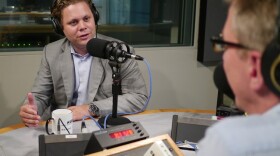Bob Ray Sanders is a longtime columnist for the Fort Worth Star-Telegram, but his roots go even farther back at KERA. Forty years ago, he was a reporter for “Newsroom” on KERA-TV – the show where he and Jim Lehrer got their starts. Sanders and Lee Cullum actually helped pull the switch on July 11, 1974, that launched KERA radio. To mark the radio station’s 40th anniversary, he shares these memories.
Some people were betting it would never work. A public radio station in Dallas/Fort Worth?
I certainly had my doubts.
Our CEO, Bob Wilson, had thought of starting a radio station for a while, and I think he encountered some resistance because people felt the market already was flooded with dozens of radio stations, including Top 40 powerhouses, a couple of megawatt stations with large audiences and WRR, which was owned and operated by the city of Dallas. WRR had the classical market, and there were important people in the community who didn't want to see a publicly-funded station competing with it.

At any rate, Bob, with the help of public broadcasting pioneer Ralph Rogers, raised money to put together a station that would be housed in "The Little Red School House," originally a DISD-owned building used for some of those early "educational" programs for TV where people literally stood in front of blackboards to present a program.
Birth Of A Station
Before signing on the radio, KERA took out full-page ads in Dallas and Fort Worth newspapers announcing "Birth of a Station," which I must admit was a catchy slogan, but one that caught a few people like me off guard, considering it was based on the title of one of the most racist, stereotypical films ever produced, D.W. Griffith’s "Birth of a Nation."
At any rate, we officially signed on the radio airwaves right after a “Newsroom” program on TV, which ended five minutes early that evening. There was a switch that had been set up in the “Newsroom” studio, and after a countdown, a group of people -- including Bob Wilson and radio station manager Bruce McKenzie -- pulled that switch. Lee Cullum, then the host of “Newsroom,” and I were also there for the historic moment.
The radio station, of course, was subsidized by the TV station in the beginning, but the plan was that it would have to quickly wean itself of TV and start to pay its own way -- through pledge drives, of course, but also by securing its own underwriting for programs.
(Pledging was tough, because although we'd gotten people used to the idea of donating money for public TV, it was hard to convince them that they should also help fund radio).
As Changeable As The 'Texas Weather'
The early programming included BBC World Service in the early morning; classical music from 9 till noon, and an afternoon program called "Texas Weather," hosted by program director Tony Garrett. It was an eclectic music program that on a second's notice could switch from Beethoven To Basie, or from Broadway to bluegrass – as changeable as the Texas weather.
“All Things Considered” was the flagship program from NPR then, and the one NPR show we aired.
Although I worked for the TV side, I often did things for radio like hosting one of the Saturday "Blockbusters" a few times a year and some special news reports.
In 1976, when radio manager Bruce McKenzie was leaving, our CEO called me into his office one day. Frankly I thought there was a problem, but then he began to talk about how he had noticed how much I loved the radio station and asked, "How would you like to be manager of KERA-FM?"
I was totally caught off guard. And I told him, not only did I know nothing about managing a radio station, but I didn't know anything about management at all. To which he said, "No one does, until they do it."
He said, "We can get you the management training. Just bring the passion."
"And, oh," he said. "You have 24 yours to decide."
I thought about it, and accepted. He enrolled me in a special program that the Corporation for Public Broadcasting had started with the Harvard University business school designed to teach public broadcasters how to manage. I spent two-and-a-half weeks in this intensive program, and started trying to manage a radio statoin. I later would attend a similar program at the University of North Carolina.
Early 'Morning Edition'
It was a time when pubic radio was still coming into its own nationally -- studying ratings info, scheduling and new programming ideas.
Locally, I started hosting a program called "Morning Edition" -- a one-hour newscast from 7 to 8 a.m., using stories from our TV reporters.
KERA became an important barometer for NPR. I was often called to Washington, D.C., for planning strategies, including to discuss creating a morning news show and a business program. And KERA was usually the first to sign off on a new idea because we needed the programming. The stations in other large markets, for the most part, were committed to their classical music programming and didn't want to talk about change.
It was while managing KERA radio and looking for a different kind of program that led me to the great Ossie Davis which, in turn led to KERA-TV producing a PBS series with Davis and his actress wife, Ruby Dee.
Although it has been years since I've been employed in public broadcasting, I have never severed my bond with KERA Radio, for it is, and always has been, family.





